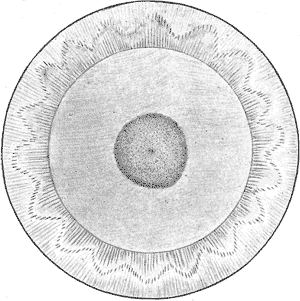
21-year-old female with history of bilateral congenital cataracts. This is called a "Coppock cataract," also known as a "central pulverulent cataract." It refers to a pulverulent disc-like opactiy involving the embryonal and fetal nucleus with many tiny white dots in the lamellar portion of the lens. It is usually bilateral and dominantly inherited.
The patient's mother and older sister also have nearly identical-appearing cataracts. These cataracts were not removed, because in this case, they were non-amblyogenic. Patients with this type of congenital cataract often have excellent visual acuity and are unaware that they even have a cataract. This patient has 20/20 visual acuity.
Historical Images from Nettleship 1906


Ophthalmic Atlas Images by EyeRounds.org, The University of Iowa are licensed under a Creative Commons Attribution-NonCommercial-NoDerivs 3.0 Unported License.